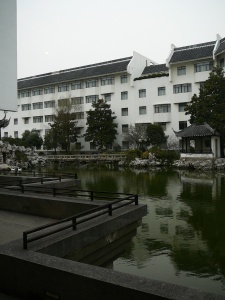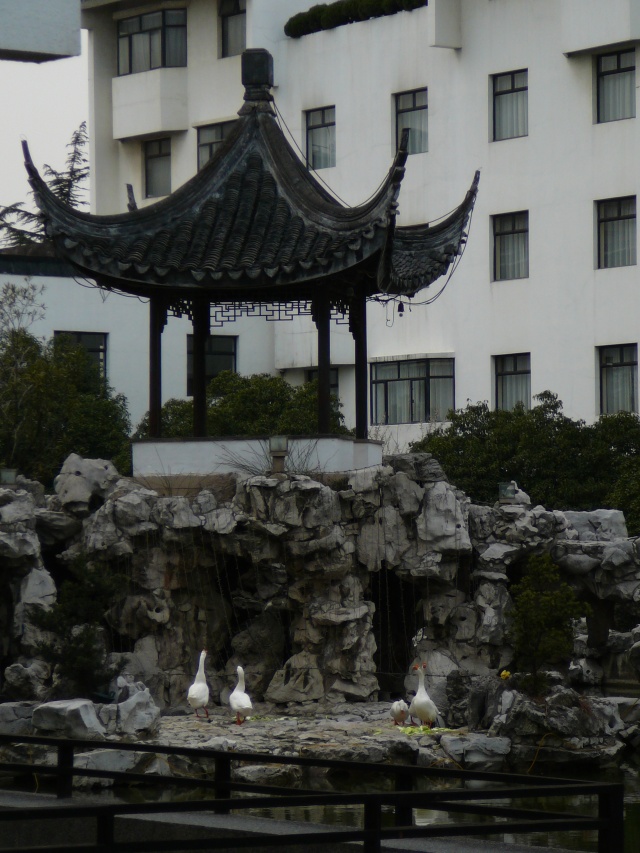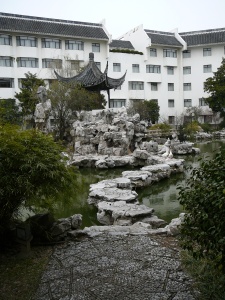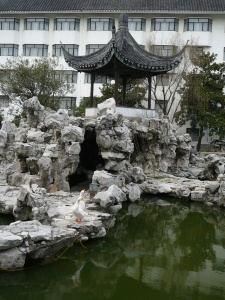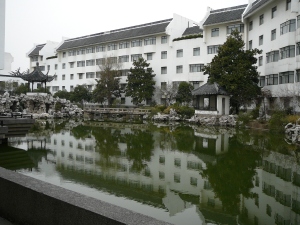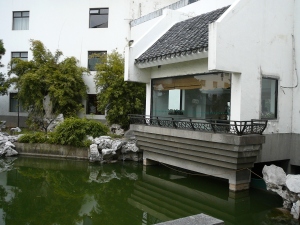“There are 4 characteristics of the Taihu Rocks,” explained Wang老师: “瘦,漏,透,皱.”
I was amused by how they all rhyme. shou4, lou4, tou4, zhou4 (pronounced similar to “show, low, toe, Joe”).
(see some images here: Taihu Rocks in the Portland Chinese Garden)
Wang老师 had wanted to walk around the hotel courtyard before we rejoined the rest of the faculty and dug in to the International Women’s Day buffet dinner. I enthusiastically agreed. As we walked, she gave me a mini-lesson in the landscaping and architectural features of the classic Suzhou-style courtyard. I was familiar with some of the features, having been through the LanSu Garden in Portland a few times. The tall blobby holes-in-them rocks come from Tai Lake (太湖 Tai4Hu2). The LanSu garden has many, and there is even one just sitting in downtown Portland at the Terry Schrunk Plaza. It was a gift from Suzhou Mayor Zhang Xinsheng to Portland Mayor Vera Katz in honor of the sistercity-ship.
Taihu Rocks have been used in Suzhou gardens for centuries and are prized for 4 characteristics in particular:
瘦
– shou4 – “thin” – being tallish and thinnish as opposed to round or circular.
漏
– lou4 – having many holes (like swiss cheese!)
透
– tou4 – letting the light leak through. Yes, there is a word for that!
皱
– zhou4 – being “wrinkly”, the rock surface has an appearance like that of being folded or wrinkled.
The Taihu Rocks were surrounding a 石山 – shi2shan1 (rock mountain) – a landscaped mountain made of rocks. “Oh, when I was small, I loved to climb up the 石山 – let’s go over there,” But alas, when we walked around, we were blocked from entering the path up to the 石山 by a rope cord and a sign. “Oh no!” she said. “Well, this is China,” I joked, “so you can just go around, right?” I was glad that she laughed and said “I guess that’s a good reason!” as we continued on. Just as well, I suppose. The 石山 was on the other side, but so were the ornery-sounding white geese.
“Did you see the 九曲桥?” she asked.
“The what?”
She pointed to a bridge on the other side of the pond leading from the 石山. I hadn’t noticed from my perspective, but the bridge wasn’t straight – it kinked back and forth, making little zigzags between the 石山 and the pathway around the pond. I was familiar with the practice of not making straight paths. In many Chinese gardens, you cannot see or walk directly from one point to another. At LanSu Garden, I’d learned that this serves the double purpose of embedding intriguing shifts of visual perspective and framing within the garden, as well as preventing malicious spirits from having a straight shot from the beginning to the end of a path. In addition, many doorways have a little bump at the threshold which humans must step over, but bad spirits apparently cannot.
The bridge was called a 九曲桥 – Jiu3qu1 Qiao2 – 9-zigzags bridge.
And then, just as we were re-entering the hotel to head back to the buffet, she pointed out the 3 different styles of pagodas – 亭子 (ting2zi) – in the courtyard. The first one on the far left, sitting atop the 石山 is the one I most recognized as a pagoda, but there were two more. The middle one had a different kind of roof and seemed to be sitting in the pool like a small island. The last one, jutting out from the hotel on the far right, was a classic “一半亭子” yiban4 Ting2zi – a “half pagoda”. Apparently, these are made to have one half on land, and the other half hovering on stilt-legs above the water.
“Thank you for explaining all these things!” I said as we returned to the dinner. “Oh, it’s my pleasure,” Wang老师 replied graciously. “It’s fun for me too, I get to see new things with you that I don’t notice otherwise, because its all normal for me!”
